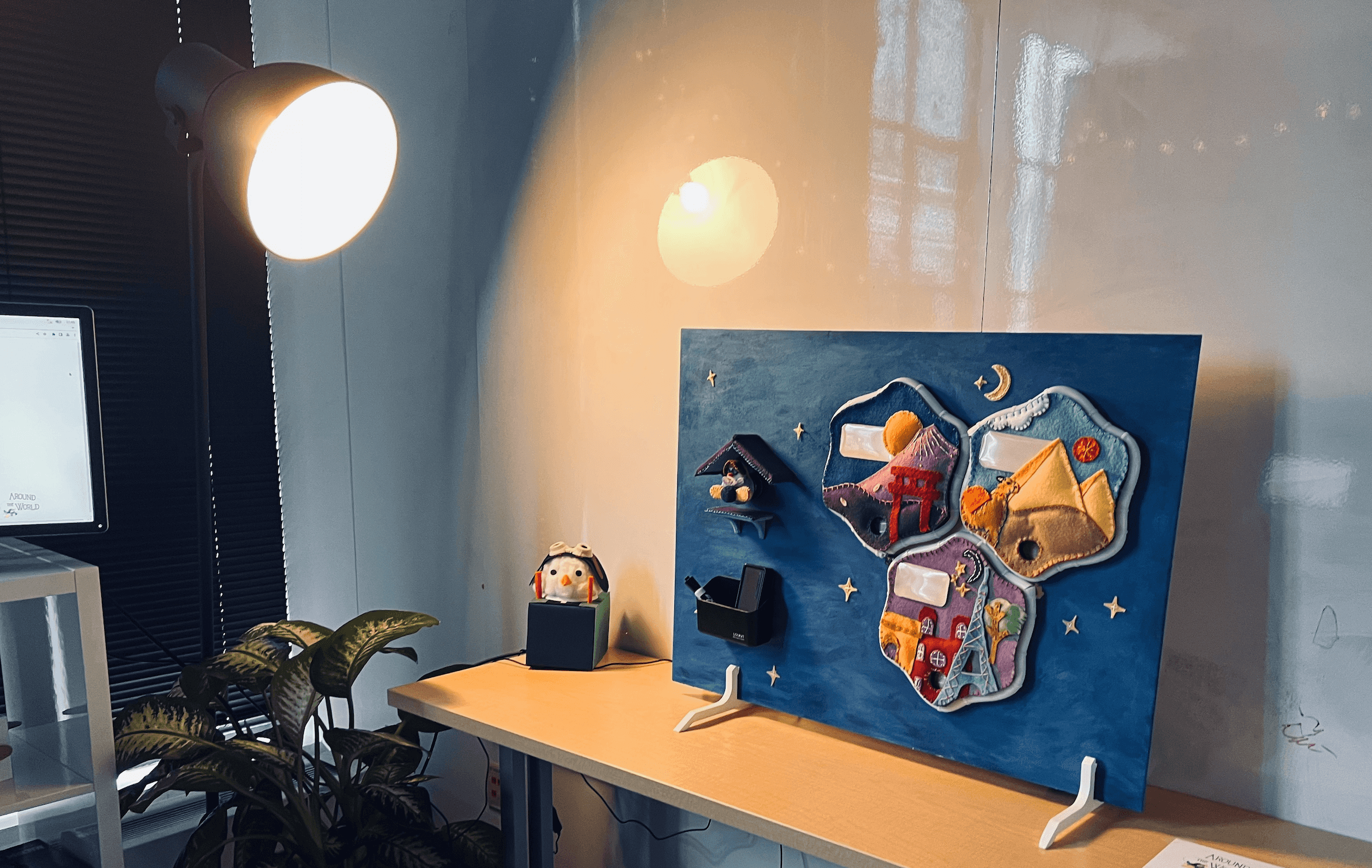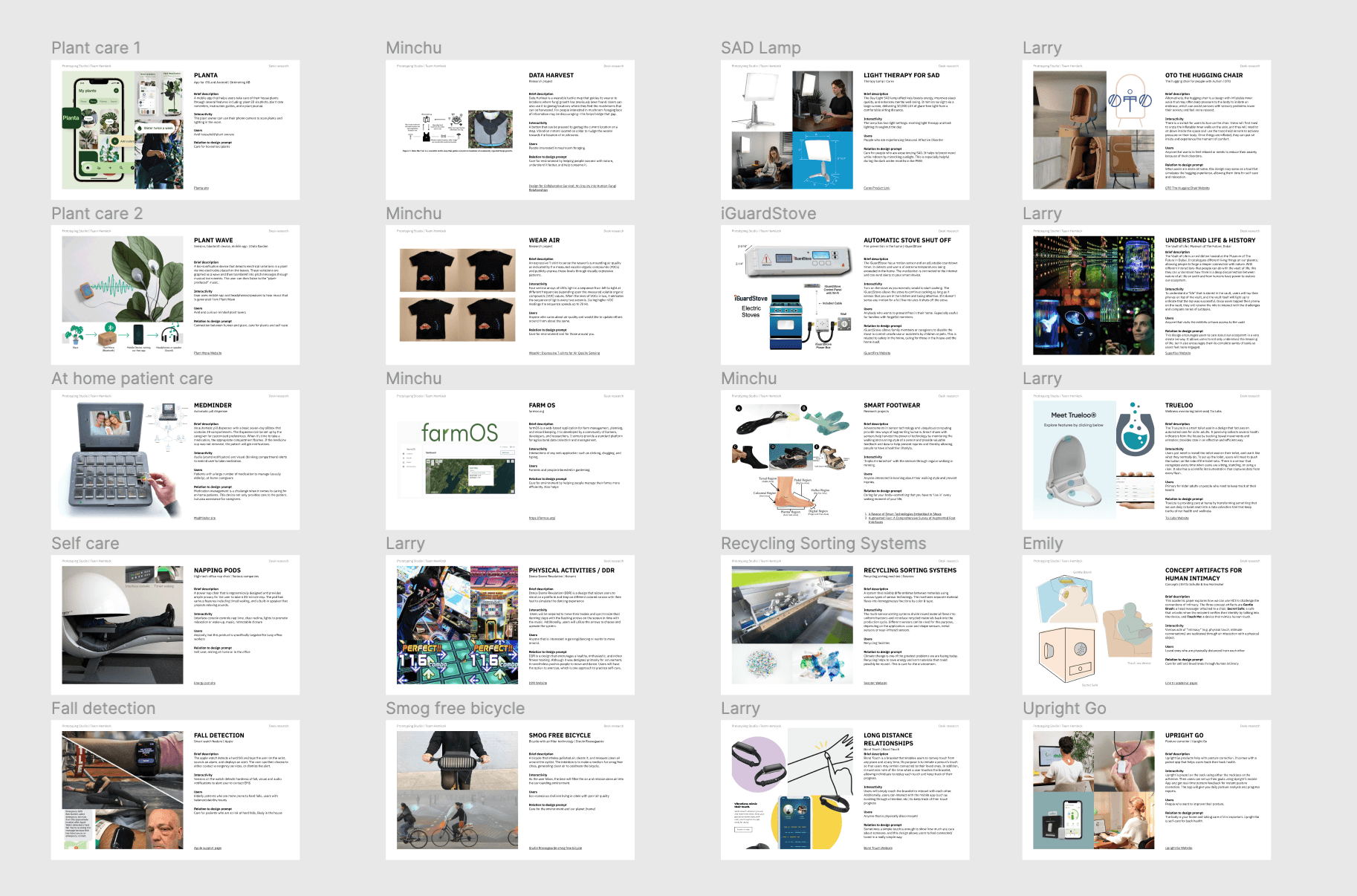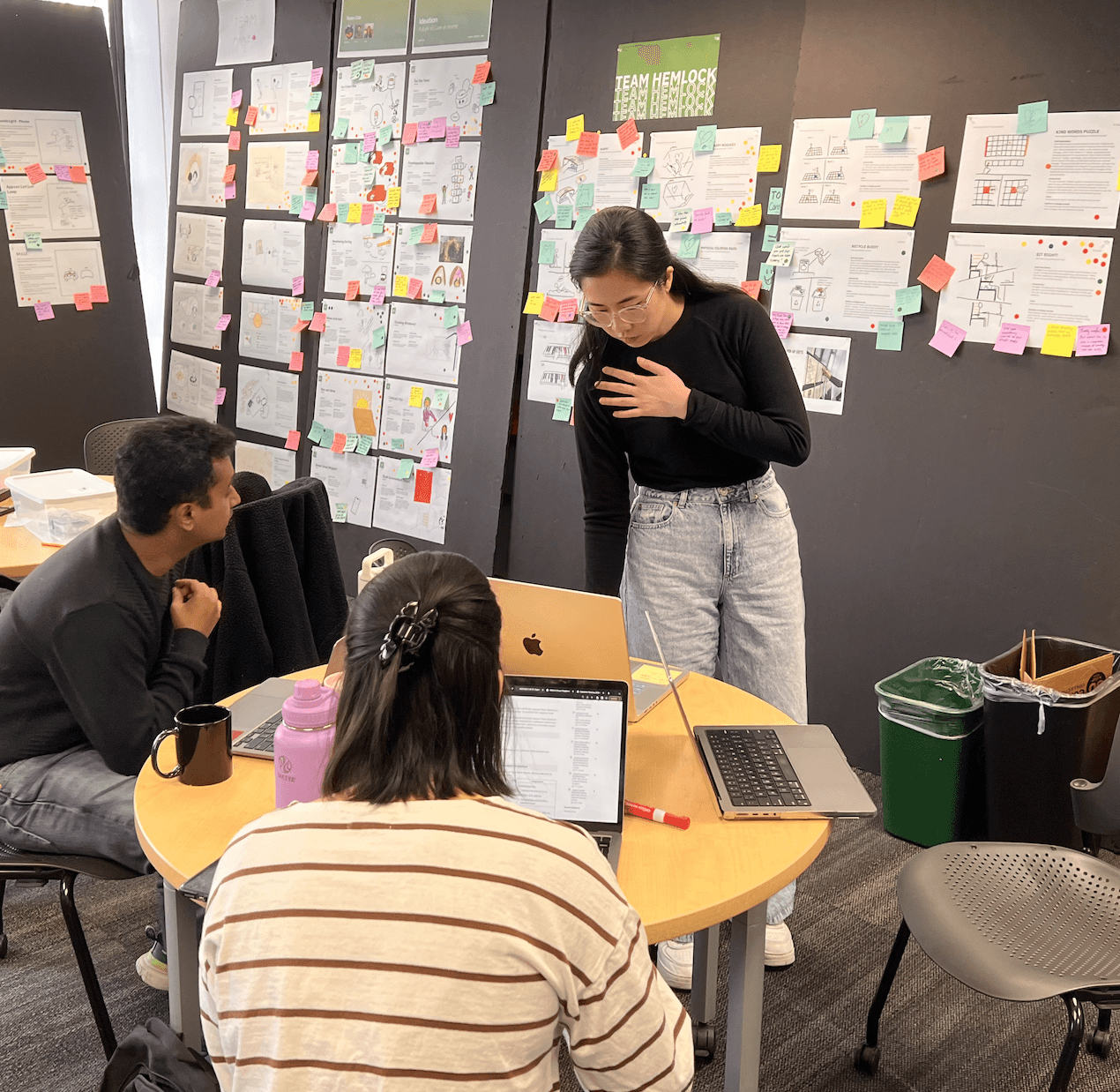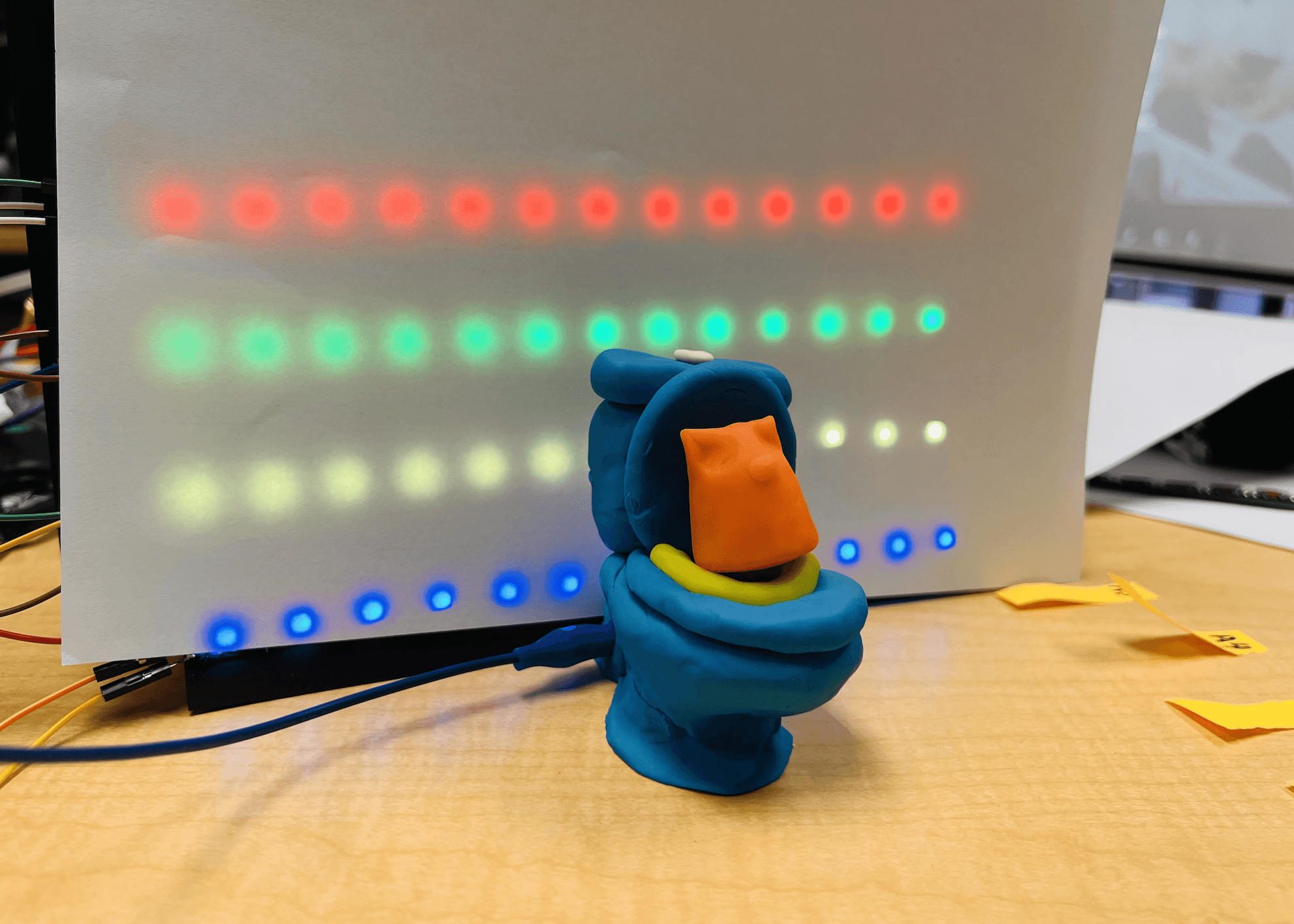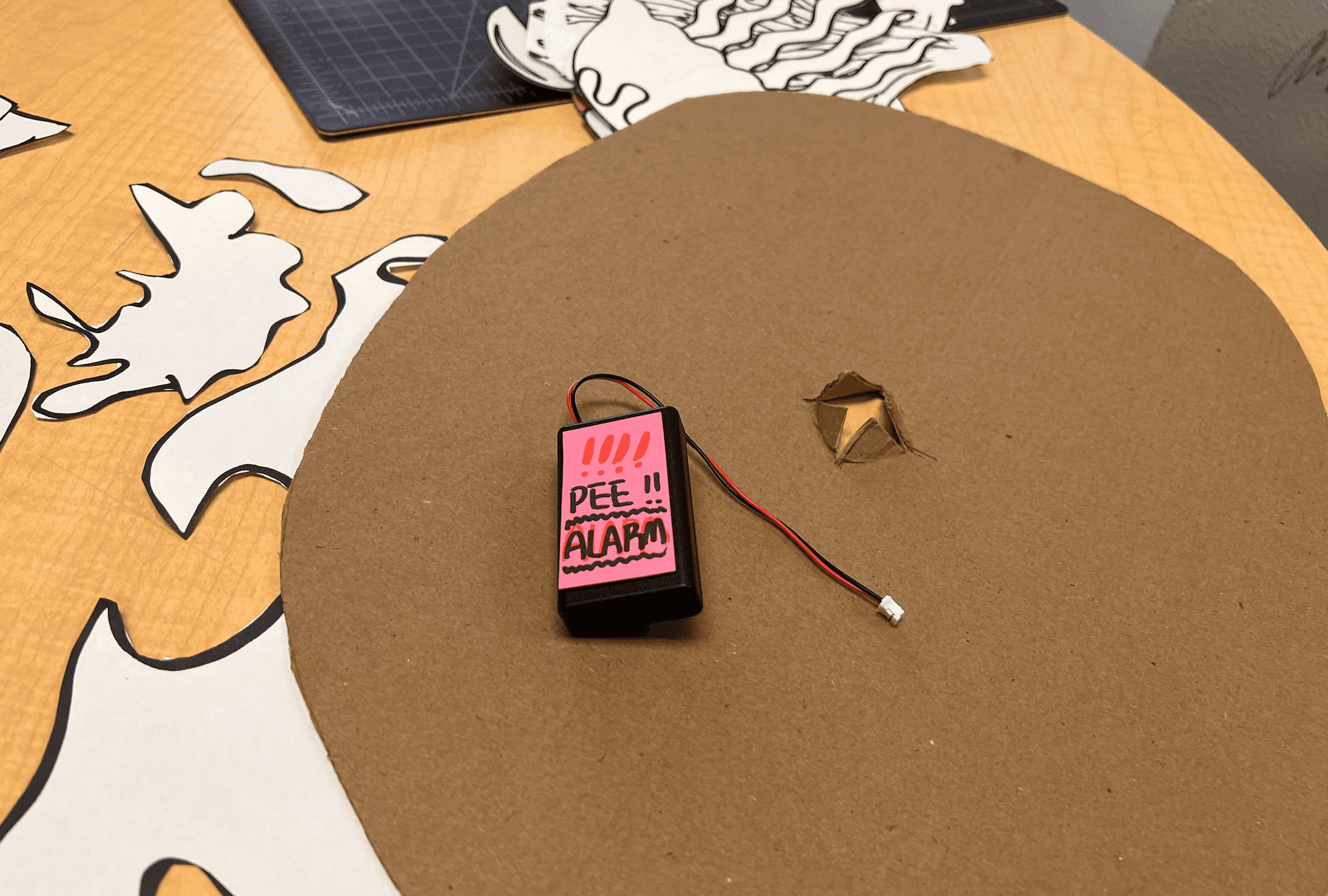Around the world
An interactive checklist that helps kids develop and follow bedtime routines
/PrototypING + Usability Testing
TIMELINE
10 weeks
ROLES
Product Designer
User Researcher
Prototyper
ADVISORS
Scott Ichikawa
Jon Froehlich
TEAM
3 Designers
1 Engineer
OVERVIEW
Over a span of 10 weeks, the team discovered that children frequently struggle with sticking to a bedtime routine, leading to issues like bedwetting. To address this, our team developed Around the World, a dynamic checklist that enables parents to establish and sustain a structured bedtime routine for their kids.
Over a span of 10 weeks, the team designed, tested, and refined the design using various types of prototypes, with the goal of assisting parents rather than replacing them by reducing stress and anxiety associated with bedtime routines. Our design incorporates lights, audio, and captivating facts from different parts of the world to engage and inspire children to complete their pre-bedtime tasks.
MY ROLE
As the UX designer on the team, I was responsible for:
Conducting desk research to understand the problem space
Brainstorming ideas, creating wireframes, and building prototypes
Moderating 4 usability testings with parents and children
Conducting 4 user interviews with parents and synthesize findings
Iterating designs to address findings from usability testing
Documenting the overall process with photos and videos
Problem definition
The design prompt was to design a new interactive digital-physical artifact that mediates care in the home. To investigate the broad prompt, our team conducted extensive desk research and literature reviews to gain a better understanding of the various types of care and the specific challenges associated with them. In addition, for each identified problem, we brainstormed potential design concepts.
Different types of care our team explored
The ideas we brainstormed based on our initial findings from different problem spaces
Taking into account factors like alignment with the design prompt, feasibility, peer feedback, and personal interest, we used a dot-voting method to narrow down our problem space. As a result, we decided to focus on the area centered on parent-child care.
We received feedback from our peers
We synthesized all the feedback as a team
After conducting more preliminary research on home challenges related to child-parent relationships, the team found that some kids struggle with bed wetting problems even after being potty trained, and one reason for this problem was that kids are not following bedtime routines and not using the bathroom before bed.
Therefore, we set our target audience to be kids that are within the age of 5 - 8 and landed on the following design challenge:
Initial Design Challenge
How might we motivate children to use the bathroom before bed to prevent bedwetting?
Prototyping as Research
Because we already had a design idea in mind when we identified our problem space, we wanted to prototype and conducting usability tests to determine if it can be developed into a viable product.
Hypothesis
Recognizing assumptions
After conducting initial research on children's reluctance to use the bathroom, I formed assumptions about their lack of motivation due to the uninteresting nature of the bathroom experience.
Other assumptions
It's hard to test with children
Children enjoy positive reinforcement
Parents struggle to get their kids to use the bathroom
Bedtime stories can be used to motivate children
Desk research
Since I assumed that the bathroom experience was not entertaining enough to motivate children to use it before bed, I conducted additional desk research on children's behaviors to see what are the motivators I can use to encourage children to use the bathroom.
During this process, I reviewed 5 articles related to children's bedtime behaviors, and I conducted competitive analysis with existing tools such as bed alarm to understand the strengths of those solutions and identify space for improvement.
Primary Research Goal: to collect valuable data to improve my understanding of what is a common motivator for children; to identify opportunities and develop the features required to make the product viable.
Method Rationale: allowed me to efficiently collect data while identifying design opportunities in a timely and accessible way; helped me make informed design decisions and avoid unnecessary work.
Hypothesis: kids don't like going to the bathroom before bed because its experience is not fun enough to motivate them.
Outcomes
Use light shows to motivate children
Use voice assistant to provide instructions
Add limitations to prevent any disruption to children's sleep
The team created a bathroom wall with a light show to simulate the experience
I created a bed alarm prototype to demonstrate the disadvantage of it in our next step
The team compiled all of our findings and brainstormed the structure of the design to address the identified opportunities.
Overall process
Video Prototype
WoZ Prototype
Mid-Fi Prototype
Final Prototype
Video Prototype
For video prototype, I was responsible for creating the video props, sketching wireframes, setting up the space, co-shooting the video, presenting our ideas, and collecting feedback from our peers the next round of iteration.
Primary Research Goal: to gather feedback on two intervention methods in order to determine the optimal approach for our design.
Method Rationale: provides opportunity for us to embody ourselves and imagine how children will interact with our designs; it enables timely and cost-effective evaluation of the user experience prior to implementation.
Hypothesis: the voice assistant instructions in our design are cohesive and interconnected, allowing users to seamlessly comprehend each step.
Outcomes
We need to minimize the steps included in our design to avoid confusions
Going with narratives instead of fun facts
The concept of an interactive world map needs to be further tested
Ackowledge children's diverse interests
Interactive high-fi prototype
When building the WoZ prototype, I was responsible for creating the world map prototype, developing our study plan & session guide, soldering all of the wires, and testing all the connections to simulate feedback.
Primary Research Goal: to assess parent involvement and interactions during the user journey while evaluating the clarity of our designed components for a child's understanding.
Method Rationale: examines user interactions and behavior through manipulated input, fostering open-ended engagement, and gathering insights on the response to our envisioned technology prior to implementation.
Hypothesis:
The bedtime story will motivate children to use the bathroom
Lights can capture children's attention, initiating their engagement with the voice assistant
Children can understand and follow voice assistant instructions
Children can comprehend the "world map" concept
Positive reinforcement promotes a sense of accomplishment and serves as a motivator for children to use bathrooms before bed
OutComes
Our design should enhance the bonding experience of parents and children during bedtime stories, not substitute it
The "world map" concept had to be redesigned
Lights could become a distraction for children before bed
Positive reinforcements brought joy to children
The number of interactions still needed to be reduced
Safety was a big concern for parents
Pivoting
After talking with those parents, the team discovered numerous inconsistencies in our user flow and realized that addressing bedwetting as a problem space required a thorough understanding of medical factors.
We reconsidered our problem space and conducted another two interviews with parents about the parenting issues they face before their kids' bedtime. Upon data analysis, a particular quote stood out to us:
In relation to the findings from the Woz Prototype testing, my team discovered that parents preferred structured routines for their children right before bedtime. With this finding, we refined our design challenge:
Refined Design Challenge
How might we help kids build, structure, and keep track of bedtime routines?
Re-Ideating
To address this new design challenge, my team re-ideated 10+ ideas.
The team discussing about potential checklist ideas
By connecting all of our ideas to the significance of routines in families, we were able to settle on the concept of creating a checklist to help children structure their bedtime routine, and these are the key features we determined that our checklist should have:
Fun Form Factor
We want to design a screen-less form factor that is suitable for pre-bedtime use and appealing to young children.
Simple Interaction
A child-friendly interaction that is easy to understand and use.
Delight Factor
Include a small element of delight to encourage and motivate children when they complete a task on the list.
Enticing Feedback
Providing fun and enticing feedback to encourage children to complete a task and check an item off the list
When building the mid-fi prototype, I was responsible for ideating, sketching wireframes, building low-fi prototypes, developing our study plan & session guide, documenting the process, soldering and connecting wires, and building the MVP prototype.
Primary Research Goal: understand how participants perceive our new checklist design, as well as test its usability; identify potential areas for improvement before building our final prototype.
Method Rationale: allows us to quickly collect input and discover areas for development, directing us to a better path and uncovering underlying issues that we may have overlooked when ideating.
Hypothesis: our design will be perceived as something that is easy to interact with, and it will motivate children to complete the tasks assigned on our designed checklist.
Outcomes
The theme needs to be customizable to suit different children's interests
Learned that participants perceive our design as something that is simple and meets the needs of parents
Interactive High-Fi Prototype
We kept the core concept of the previous prototype while improving its appearance and quality in this iteration, and we introduced new features such as customizable themes and tasks.
During this building process, I was responsible for constructing study plan, collecting materials, building prototypes, setting up electrical connections, and designing the hanging board to connect different tasks.
Primary Research Goal: understand how children perceive our checklist design and interact with it. As well as understand parents' perception on how they think of our design (wether it's useful or can become a distraction)
Method Rationale: allows us to collect input from both parents and children and discover areas for development efficiently; directing us to a better path and uncovering underlying issues that we may have overlooked that are important from both the perspective of children and parents.
Hypothesis:
The checklist will not become a distraction for children's before bed
Children will understand how to check off a tasks with the tapping function we designed
Parents will understand how the current design provides customizability
Children will enjoy the fun facts provided by our design and be motivated to finish the tasks
Outcomes & Design impact
Parents liked the customizability of writing their own tasks for their children
The checklist helps parents add structure to their children’s bedtime routine
Most parents liked the aesthetics of the form and don't see it as something that is distractive for their children
REflections
If we had more time, I would…
Conduct more research so we can understand the problem space better before prototyping
Conduct usability testing of our final prototype in a child's bedroom
Spend more time to structure the testing sessions with children
Conduct co-design sessions with children to better understand what motivates them
What I learned
Try to iterate on the gained knowledge and prototype before pivoting
Ideation and research go hand in hand
Design can be utilized as a form of problem setting
Testing with and designing for children is challenging, and it is important to acknowledge the assumptions we made along the way
It is ok to be "good enough" and move forward when we are stuck
